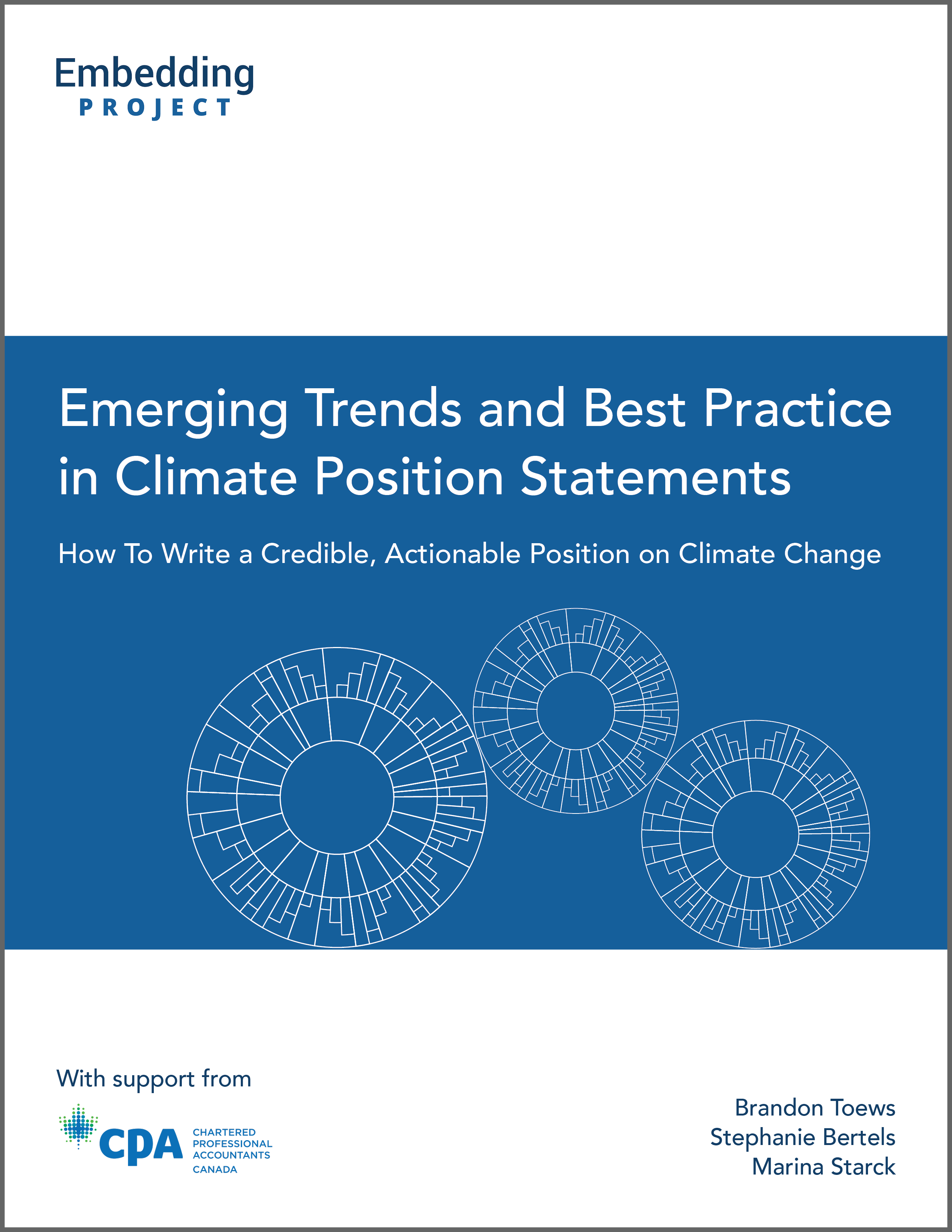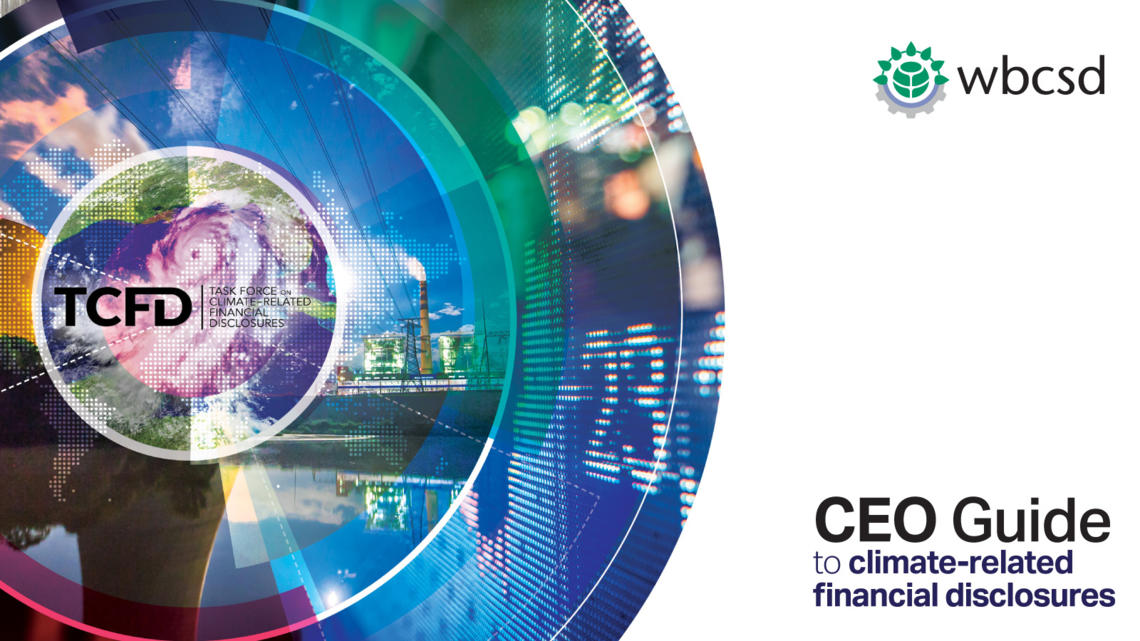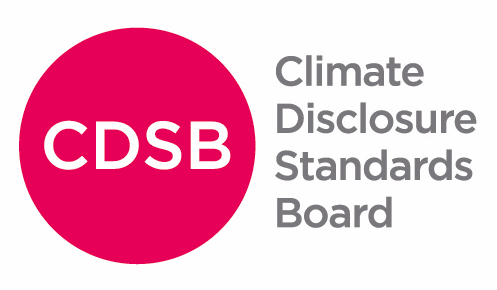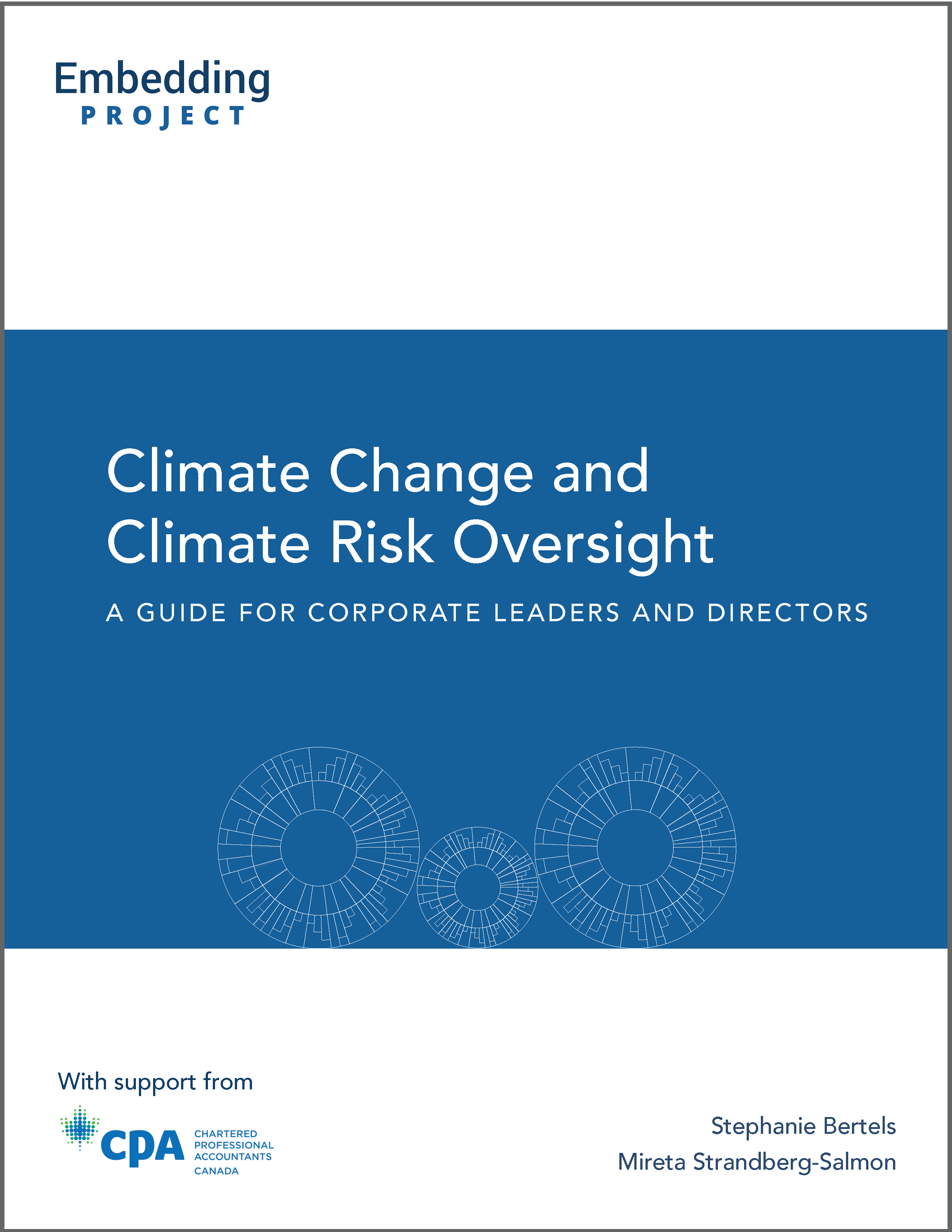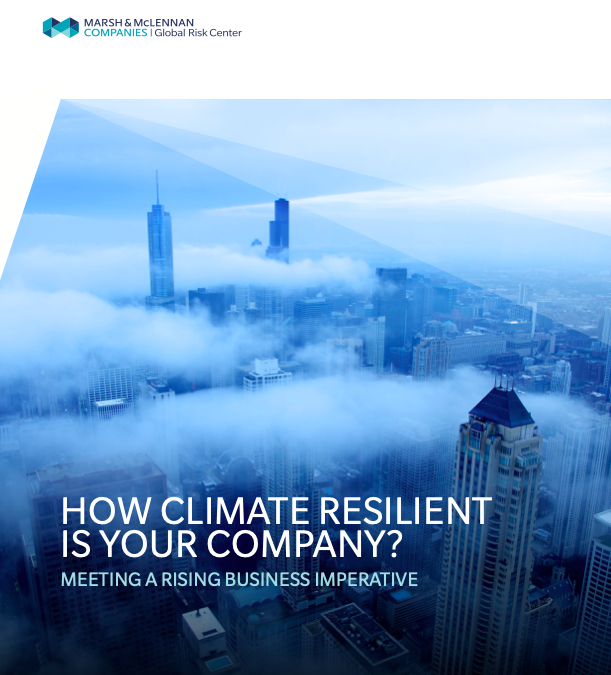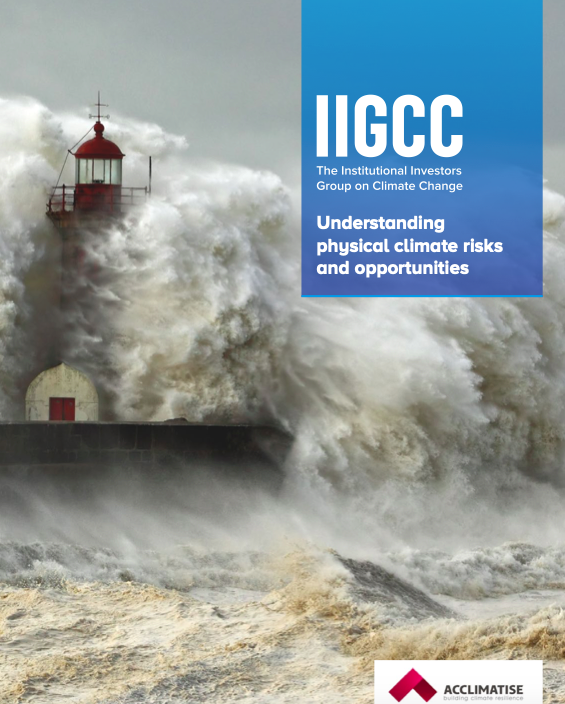Climate Risk Preparedness and Adaptation
Description
Including scenario-planning; climate risk assessments; climate adaptation planning; investments into resilient company, supplier, community, and public infrastructure; flood prevention and defense; early warning systems; drought-resistant plants; ecosystem restoration; supply chain climate resiliency; disaster contingency and emergency response plans (co-designed with community stakeholders); reducing the impacts of climate-related disasters; supporting regional and national adaptation plans; and climate justice in adaptation and risk preparedness.
Share this Subissue on:LinkedIn
Resources
Getting Started Guide
Climate Risk Preparedness and Adaptation: A Getting Started Guide
As the impacts of climate change worsen, the resilience of our environmental, social, and economic systems will be further threatened. It is crucial that organisations understand these risks and are proactive in adapting to them. Many companies understand that they need a strategy to prepare for climate risks and adapt to climate impacts but need more clarity on the work ahead. Anchored in research, our Climate Risk Preparedness and Adaptation: A Getting Started Guide helps your company to better understand the climate risks it may face, improve its preparedness, and develop a climate adaption strategy.
Climate Scenario Informed Decision-making
Including understanding the behaviour of the climate system and identifying and disclosing relevant climate-related risks and opportunities.
The Task Force on Climate-related Financial Disclosures
Momentum is growing for organisations to formally and transparently articulate the risks that climate change poses to the value of their assets and their future profitability. The Task Force on Climate-related Financial Disclosures (TCFD) emerged as a response to this call for action, empowering companies to more effectively measure and evaluate their own risks and those of their suppliers and competitors. The TCFD promoted “consistent, comparable, reliable, clear, and efficient” voluntary climate-related financial disclosures, and has developed comprehensive recommendations and resources in support of this. These resources focus on governance, strategy, risk, metrics, targets, and the use of scenario analysis for evaluating climate-related financial risks and opportunities.
The TCFD has produced a comprehensive Final Recommendations report and several supplemental reports, including a Technical supplement, which provides in-depth information and tools for using scenario analyses to understand the strategic implications of climate-related risks and opportunities to your organisation.
Although these resources remain to be an invaluable source of guidance, the Financial Stability Board (FSB) and IFRS have announced that the TCFD has fulfilled its remit and disbanded, and that monitoring of the progress of corporate climate-related disclosures now rests with the IFRS Foundation's ISSB.
Task Force on Climate-related Financial Disclosures: Guidance on Metrics, Targets, and Transition Plans
The Task Force developed this guidance to complement their flagship report and to help change agents, finance professionals, and leaders to disclose decision-useful metrics, targets, and transition plan information and link such disclosures with estimates of financial impacts.
This guide will help you to select and disclose the right metrics and climate-related targets; understand how aspects of transition plans may be included in climate-related financial disclosures; and understand how climate-related metrics, targets, and information from transition plans provide information that can be used to estimate the impact of climate change on financial performance.
Emerging Trends and Best Practice in Climate Position Statements
Climate change is happening, and the impacts are intensifying. Companies are expected to take a position on climate change and outline an appropriate response. The Embedding Project’s climate position guide helps companies to articulate a concise and transparent board level position on climate change. Drawing on in-depth analyses of over 2,600 climate position statements, this guidebook provides a checklist for crafting a climate position statement with concrete examples from a range of industries and global settings.
CEO Guide to climate-related financial disclosures
Written for an executive audience, the WBCSD's CEO Guide to climate-related financial disclosures is a concise complement to TCFD resources. This summary guide will help bring you up to speed on investor demands for better climate system knowledge among business leaders and for the transparent disclosure of climate-related risks and opportunities.
TCFD Good Practice Handbook
This handbook from the Climate Disclosure Standards Board (CDSB) and the Sustainability Accounting Standards Board (SASB) identifies good practices in implementing the TCFD recommendations. Drawing upon a diverse range of examples, these good practices cover the four core elements of governance, strategy, risk management, and metrics and targets.
Climate Change and Climate Risk Oversight
Climate change is a planetary emergency that presents severe risks to businesses, society, and the global economy. No business, regardless of the sector, is immune – and businesses around the world have a key role to play to help avoid the worst impacts. This guide will help you understand the science behind climate change, why climate change matters to your business, and what actions your business can take to accelerate the transition to a net-zero, climate-resilient future.
Navigating climate scenario analysis: A guide for institutional investors
A key recommendation of the TCFD is for organisations to conduct scenario analyses to understand the risks and opportunities of possible climate futures, but many companies struggle with developing such scenarios. This 'how-to' guide from the Institutional Investors Group on Climate Change (IIGCC) builds on existing reports and research and will help you to create credible climate change-related scenarios. It introduces a five-step framework for understanding and using scenario analysis, and includes instructions for identifying scenario analysis objectives; understanding and selecting scenarios based on available criteria; applying scenario analysis to investments; and taking appropriate action upon review.
Climate Scenario Analysis Reference Approach
This resource from the World Business Council for Sustainable Development (WBCSD) and the Energy Forum was created to provide a common and transparent approach to the use of climate scenarios. The report describes the context and basis for the Reference Approach, and outlines the Energy Forum's rationale, principles, process, and reflections in regards to scenario analysis. This report is also accompanied with an online platform, which collates a broad range of scenarios and variables (e.g. investment, demand, emissions, capacity, etc.) and provides analysis.
Although designed with the energy sector in mind, these resources may be of help to sustainability professionals in any industry.
Scenario Planning for Climate Change: A Guide for Strategists
This book from Nardia Haigh takes a deep dive into climate change-related scenario planning and provides a framework that can help decision-makers develop a climate change strategy. The book builds on a range of rigorously tested scenario planning frameworks and provides a practical, four-step method for developing a scenario planning project. It also includes summaries of common climate change trends.
Her website also offers complementary videos, climate driver summaries, a sample scenario planning project proposal, and various worksheets to help you get started.
How to Conduct Effective Scenario Planning: An Interview with Dr. Nardia Haigh
Scenario planning is a tool for companies to prepare for the unpredictable impacts of sustainability issues. In this blog, we interview Dr. Nardia Haigh to learn more about how to conduct effective scenario planning.
Scenario Planning Made Simple: An 8-Step Method
Scenario planning is an effective strategic tool for decision-makers, but it can be challenging to know where to begin. In this blog, we break down Dr. Nardia Haigh’s scenario planning framework into eight straight-forward steps.
Push It to the Limit: Scenario Planning That Takes Sustainability Seriously
Scenario planning can be an effective strategic process for understanding risks and opportunities, but what about your company’s impacts on society and the environment? In this blog, we provide five recommendations to help create scenarios in which your company supports sustainable futures by operating within the limits of key systems.
The 2030 Calculator
Performing a lifecycle assessment can be a complex, time-consuming, and costly procedure. The 2030 Calculator from Doconomy tries to simplify this process to give companies a better understanding of their full environmental impact - quickly, and at no cost. Although this tool cannot fully replace a detailed analysis, the 2030 Calculator will help to immediately improve the impact transparency of your products and services.
Hamburg Climate Futures Outlook
Not all climate scenarios are plausible. The Hamburg Climate Futures Outlook provides a systematic assessment of the the plausibility of a climate future in which the Paris Agreement temperature goals are achieved. It applies a plausibility framework that analyzes ten dominant social drivers of decarbonization and six select physical processes of public interest. In so doing, this resource provides key findings and data that can help you to better understand the credibility of decarbonisation opportunities and outcomes, and to better prioritise the allocation of effort and resources for addressing climate change.
TPI Sectoral Decarbonisation Pathways
The Transition Pathway Initiative has created sectoral decarbonisation pathways to help investors assess whether companies in the energy, transport, and industrials sectors are delivering the emissions reductions demanded by climate science within a suitable time period. The pathways are based on scenarios from the International Energy Agency’s (IEA), and will help you to see whether the goals of companies in these sectors are aligned with the actions required and to benchmark accordingly.
Scenarios for Assessing Climate-Related Risks: New Short-Term Scenario Narratives
This report - and the accompanying visualisation tool - were created by UNEP Financial Initiative's Risk Centre to bridge the gap in short-term scenarios that explore near-term climate-related risks, economic volatility, and potential systemic vulnerabilities. They identify short-term scenario narratives that can help financial institutions and others understand the implications and drivers of a range of short-term macroeconomic, transition, and physical shocks, such as geopolitical tension, greenflation, climate migration, and extreme weather. These resources will be especially beneficial for asset managers, insurers, bankers, and investors, but would also benefit enterprise risk and sustainability teams.
Other Resources
How Climate Resilient is Your Company? Meeting a Rising Business Imperative
This guidebook from Marsh & McLennan will help acquaint you with the intersection of resilience and climate adaptation. The document provides key definitions; identifies five major groups placing pressure on companies to assess, define, and enact strategies that enhance climate resilience; and provides a 3-step approach to assessing your company's climate resilience.
Adaptation Gap Report 2024: Come hell and high water
One of UNEP’s annual flagship publications, the Adaptation Gap Report can help you understand trends in climate adaptation at both the global and regional levels. Each report offers a science-based assessment of the adaptation gap - that is, the degree to which current levels of investment and planning on climate adaptation fall short of what is needed. The reports also provide a set of adaptation measures for policymakers and decision-makers. These insights will be most useful to enterprise risk, finance, and sustainability teams.
Understanding physical climate risks and opportunities
This guidance from the Institutional Investors Group on Climate Change collates good practice for step-by-step physical risk assessment, and will help investors to better understand physical climate risks and opportunities and how they can integrate this knowledge into their investment processes. The guidance helps investors understand physical climate risks and how they are measured. This guidance also provides investors with practical advice on how they can begin to assess, analyze, measure, and manage the risks and opportunities presented by physical climate hazards. Written specifically with investors in mind, the guidance can be used without prior climate expertise.
The 2024 Climate Risk Landscape
This report from the United Nations Environment Programme Finance Initiative (UNEP FI) was created to help financial institutions better understand the landscape of climate risk tools. Climate risk tools can play an important role in helping sustainability change agents, procurement specialists, and business leaders to understand climate risks and opportunities, and to inform business strategy. This report explores key trends in physical risk and transition risk tools and provides best practices for tool utilisation, case studies, and recommendations to navigate the dynamic climate risk tools market. It also offers insights into the rapidly evolving regulatory developments around climate-related disclosure frameworks and recent market developments.
Climate Risk and Response: Physical Hazards and Socioeconomic Impacts
Climate risk is complex: impacts will grow in frequency and severity, cascading in non-linear and life-threatening ways. Although the scale and pace of climate change impacts will differ depending on location, one constant is that regional "livability" will eventually become compromised. This report from McKinsey Global Institute catalogs some of these unanticipated consequences, and will help you to grow your understanding of the risks looming between 2020 - 2050. The report explores common and prominent characteristics of physical climate risk, the non-linear nature of socioeconomic impacts, and their knock-on effects.
Climate Action Pathways
First launched in 2019 by the UN's Framework Convention on Climate Change, the Climate Action Pathways set out sectoral visions for achieving a 1.5° C resilient world in 2050. Pathways are a living document, and will provide you with an up-to-date road map of the interim actions and key impacts needed by 2021, 2025, 2030 and 2040 to achieve the 2050 vision.
The Pathways are divided into executive summaries and action tables that cover thematic areas linked to climate change, such as energy, industry, land use, transport, and water, as well as cross-cutting themes like resilience. The summaries provide a vision of the future, summarising the needs - and milestones - for system transformation and progress to date, whereas the action tables highlight specific time-bound actions that businesses (and other relevant stakeholders) can take to deliver on 2050 vision.
Climate Risk Assessment for Ecosystem-based Adaptation: A guidebook for planners and practitioners
This guide is a good starting point if your organisation is looking to preserve at-risk natural spaces from climate change impacts. The guide focuses on ecosystem-based adaptation, which involves the use of biodiversity and ecosystem services to help communities adapt to the negative effects of climate change and to reduce their risk to environmental hazards. This handbooks will help you to perform sound assessments of climate risks for social-ecological systems, and provides guidance on how to systematically consider ecosystems and their services as both a driver of risk (when function is reduced) and as an opportunity for risk reduction and adaptation. This document introduces key concepts and methodological steps relevant for ecosystem-based adaptation; identifies potential adaptation measures; and explains how to perform related planning and use risk assessments for monitoring and evaluation.
Climate Action Competency Framework
This comprehensive toolkit and guide illustrate the depth and breadth of competencies required to manage and prepare for the impacts of climate change. Building on the original Climate Adaptation Competency Framework released in 2021, the framework is divided into six domains with their own unique competency areas; these domains include leadership, working together, capacity building, climate risk assessment, climate action leadership, and solution design. These competency areas and behaviours are essential for individuals, managers, and teams to possess and refine for leading, supporting, delivering, and implementing climate adaptation plans, strategies, policies, programs, and projects. The framework provides a practical, systematic tool that can help executives, sustainability practitioners, and human resource professionals to identify necessary skills and skill gaps; monitor and assess performances; and provide an evidence-based foundation for curriculum design for education and training designers.
Adapting from the Ground Up: Enabling Small Businesses in Developing Countries to Adapt to Climate Change
Micro and small businesses (MSEs) are the core of developing ecnomies, and a crucial link in the value chains for medium and large businesses, and yet they are often overlooked on climate change adaptation efforts. This report from WRI offers specific policy interventions for policymakers, climate finance providers, and large corporations to engage MSEs and enable them to build their own resilience. This report will help you to understand the drivers of investment in adaptation, the barriers, and specific interventions your business can make to support MSEs.
Business Leaders Guide to Climate Adaptation and Resilience
This guide by WBCSD and others can help you to improve the resilience of your business against climate impacts. It explains the importance of climate adaptation; summarises the different roles business leaders have in implementing it; and outlines nine strategies for integrating climate adaptation and resilience into organisational strategy, governance, and operations. For each strategy the guide provides relevant tools, frameworks, and case studies. The final section features a series of maturity assessments tailored to business leaders that are designed to help identify next steps. The practical guidance offered will be most useful to business leaders, including the CEO, CFO, CSO, COO, and CRO.
Advocating for Change: A Compendium on Climate Mobility
This resource by the Climate Migration Council can help you understand the complexities of increasing climate change-related mobility and the need for action. The first part of the guide outlines five action areas, or “pillars”: 1) improving displacement prevention; 2) supporting disaster-affected people who persist in place; 3) enhancing mobility pathways; 4) protecting displaced persons; and 5) taking action on loss and damage. Each pillar is broken down into two or three sub-sections, and each sub-section features a backgrounder and a list of recommended actions. The second part of the guide highlights a diversity of perspectives for addressing climate mobility, including a climate justice lens, a development lens, a (human) security lens, a migration management lens, and others. Users can draw on different approaches based on what best suits their context and resonates with their target audience. These insights will be most useful to changemakers seeking to better understand how climate displacement dynamics may affect business operations and value chains.
Just Transition for Climate Adaptation: A Business Brief
This brief from the UN Global Compact can help you understand the importance of a just transition to climate adaptation. It emphasises the role of businesses in supporting a just transition by including workers, suppliers, and communities in their climate risk management and adaptation approach. It explains how adapting to climate risk in a just and equitable manner can mitigate systemic risks and avoid adverse political, economic, and social restructuring. It also features a range of recommendations for businesses seeking to advance a just transition for climate adaptation. This resource will be most useful to sustainability practitioners, enterprise risk teams, and supply chain management teams.
Accelerating Business Action on Climate Change Adaptation
This paper from PwC can help you to better understand climate adaptation and drive positive change within your organisation. It sets out the business case for climate adaptation, presents a three-pillar for action; and shares examples from organisations that have implemented these actions.
Taking Stock of Business Efforts to Adapt to Climate Change
This short report from PwC provides a stocktake on corporate climate adaptation that can help you to understand the status of these efforts and opportunities for businesses to scale up and sustain them. It explains the role of businesses in supporting adaptation efforts; current efforts by businesses on adaptation; the drivers and barriers to business action; and specific recommendations for action.
Private Sector Initiative (PSI) database
Does your business have a specific adaptation challenge it is trying to solve? If so, this repository of research, reports, and other documents may help you to find specific, sector- and activity-relevant solutions to unique climate change-related problems.
Getting Locally Led Adaptation Right: Examples from Around the World
Climate change is a global crisis with distinct local impacts, and yet adaptation projects are rarely locally led. This article from WRI highlights examples of local adaptation done right, and can help you to better understand the range of opportunities - and challenges - related to local adaptation efforts.
WRI has also produced eight principles for locally led adaptation to help guide the adaptation community, and a working paper that highlights 21 case studies of collaborative, locally led adaptation projects to inspire and inform change agents and leaders.
Just transition litigation tracking tool
The trend of systemic abuse of communities and workers in renewable energy value chains has created a surge in litigation from Indigenous Peoples, communities, and workers. This tracking tool from the Business & Human Rights Resource Centre was created to be the primary hub for just transition-related litigation lawsuits against companies or states for authorising a specific business activity linked to transition mineral mining or the renewable energy sector. It allows you to search by type of lawsuit, company, project, sector, natural resource, rights impacted, and more.
Rising to the Challenge: Success Stories and Strategies for Achieving Climate Adaptation and Resilience
This report from the World Bank can help you understand how you can advance climate adaptation and resilience. This is a comprehensive resource that primarily covers adaptation in international development and the public sector; the sections directly relevant to business are the introduction, which explains the growing and unequal risks being created by climate change, and section 1 in chapter 3, which looks at business action in the agriculture, energy and infrastructure, and finance sectors. For each sector it provides a series of concise examples and lessons learned. This resource will be most useful to sustainability, risk, and operations teams working in relevant sectors.
What Would Cities Look Like With 3 Degrees C of Warming vs. 1.5? Far More Hazardous and Vastly Unequal
This article from the World Resource Institute (WRI) can help you understand the difference between climate impacts in a world with 1.5 °C warming versus one with 3 °C warming. Based on WRI’s own study, it shows the potential increases in heat and disease-related hazards across nearly 1,000 large cities that make up a quarter of the global population. It compares heat wave duration and frequency under both levels of warming and examines the rising demand for cooling and thus energy across geographies. It also explores how rising temperatures affect disease vectors, showing that tropical viruses like Dengue, Yellow fever, and Zika are expected to become major health risks in some regions. It breaks down these conditions related to heat and disease across regions and income levels and reveal how climate risks compound and amplify the impacts on low-income cities. These insights, combined with compelling data visualisations, will be most useful to sustainability and risk teams.
Climate change adaptation guidelines for ports
This document provides a structured framework for climate change risk and vulnerability assessments, and will help you establish context; identify, analyze, and evaluate current and future risks; and identify and prioritise adaptation options. Although written specifically for the marine industry, the framework and recommendations can be applied broadly. We will also evaluate and include climate adaptation resources relevant to other sectors as they emerge.
The Cost of Inaction: A CEO Guide to Navigating Climate Risk
This report from the World Economic Forum and Boston Consulting Group can help you to understand growing corporate climate risks and the opportunities for businesses to lead by investing in adaptation, resilience, and decarbonisation. The report explains the impacts that climate inaction are having on the world economy, and how these impacts will continue to grow and accelerate; explores the corporate cost of global inaction due to rising physical risks, as well as the growing impacts of transition risks; and explains how companies can unlock new growth by advancing the climate transition. It also provides guidance that highlights core actions and enablers for climate leadership from CEOs.
Business on the Edge: Building Industry Resilience to Climate Hazards
This report from the World Economic Forum and Accenture can help you to understand the critical need for investing in resilience and adaptation, as well as for developing strategies that account for the realities of the linked nature and climate crises we all face. It explains how these crises will affect fixed assets and threaten profits; how Earth systems are reaching and breaching tipping points; and how climate change effects are threatening socio-economic systems. It also provides a recommendations framework and industry briefs with sector-specific data. This guide will be most useful to sustainability, finance, and strategy professionals.
Too Hot to Think Straight, Too Cold to Panic: Landing the Economic Case for Climate Action with Decision Makers
This report from Boston Consulting Group (BCG) sets out the economic case for climate action and can help you to better understand and communicate the need for investing in climate mitigation and adaptation. The report explores the physical impacts of climate change, the economic damages, and the barriers to economically rational climate action. It also highlights five priorities for leaders: reframing the debate on the costs of climate change; creating transparency on the net cost of inaction across all actors; strengthening national climate policies to accelerate mitigation and adaptation; reinvigorating international cooperation on climate change; and advancing our understanding of the net cost of inaction. This resource will be beneficial to a broad range of corporate professionals, including sustainability, strategy, and finance teams, as well as senior leaders and board members.
The Climate Mobility Case Database
This free-to-access global database can help you to track and advance the rights of climate-displaced communities across the globe. Co-created by the Global Strategic Litigation Council, Earth Refuge, the Raoul Wallenberg Institute, and the Zolberg Institute for Migration & Mobility, with support from DLA Piper and Eversheds Sutherland, the database was designed to support civil society to effectively advocate for the rights of all people facing displacement in the context of the climate emergency. It collates and summarises judicial decisions concerning all forms of internal and cross border climate-related (im)mobility, providing comprehensive insights into previous legal cases and emerging trends in the area of climate displacement.
Neighbourhood Futures: A framework for climate resilience and health equity
Heat stress is now the leading cause of weather-related deaths around the world, and urban communities are disproportionately affected — often due to a lack of green space and a predominance of concrete structures and streets that absorb heat. This framework from Ramboll and Impact on Urban Health was designed to enable the development of more comprehensive, diverse, and locally sensitive climate-related strategies that can help you to explore vulnerabilities and embed climate resilience and health equity into urban areas. The framework sets out five complementary capacities that can be used collectively to examine local conditions, evaluate plans and strategies, and shape new projects. These include threshold capacity (understanding the spaces and individuals within communities that are the most vulnerable to extreme temperatures), coping capacity (preparing neighborhoods for extreme weather events when temperatures exceed safe thresholds), recovery capacity (enabling neighborhoods to restore livability and health by assessing the negative impacts of climate change and distributing resources to the most appropriate places), adaptive capacity (making the right changes to protect people and places from extreme hot and cold waves), and transformative capacity (reimagining systems to make neighborhoods more resilient and equitable). This resource will be of particular use to professionals working with urban planners.
Strengthening the investment case for climate adaptation: A triple dividend approach
The global need for adaptation finance far exceeds current public and private flows, and a key reason for this gap may be incomplete information on the costs and benefits of addressing climate risks. This working paper from the World Resources Institute can help you to better understand the value (and importance of) scaling adaptation finance. The paper is underpinned by the 'Triple Dividend of Resilience' (TDR) framework, which considers avoided losses (first dividend), induced economic or development benefits (second dividend), and additional social and environmental benefits (third dividend) of adaptation actions. The paper evaluated the full benefits of 320 climate adaptation investments in agriculture, water, infrastructure, and health across 12 countries between 2014-2024, and found that every $1 invested in adaptation can yield over $10.50 in benefits, with average returns of 20–27%. This resource will be especially beneficial for board members and senior leaders, as well as sustainability and finance professionals.



